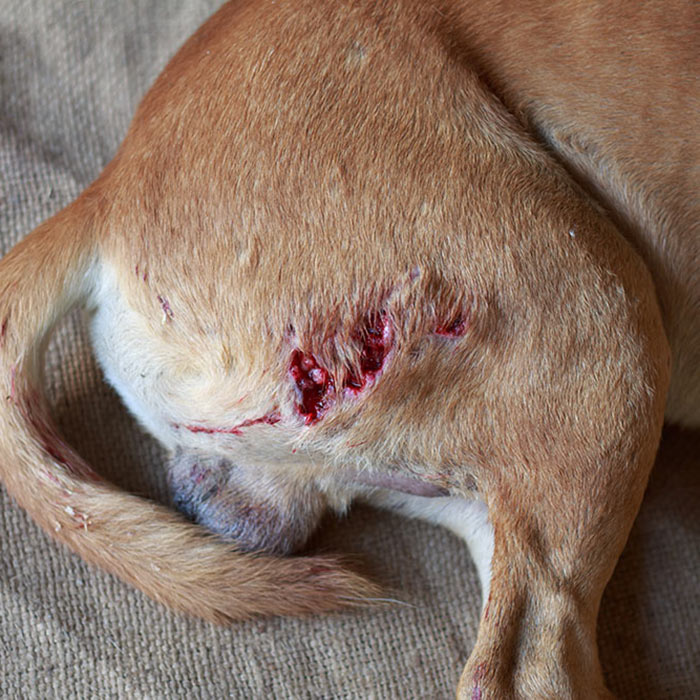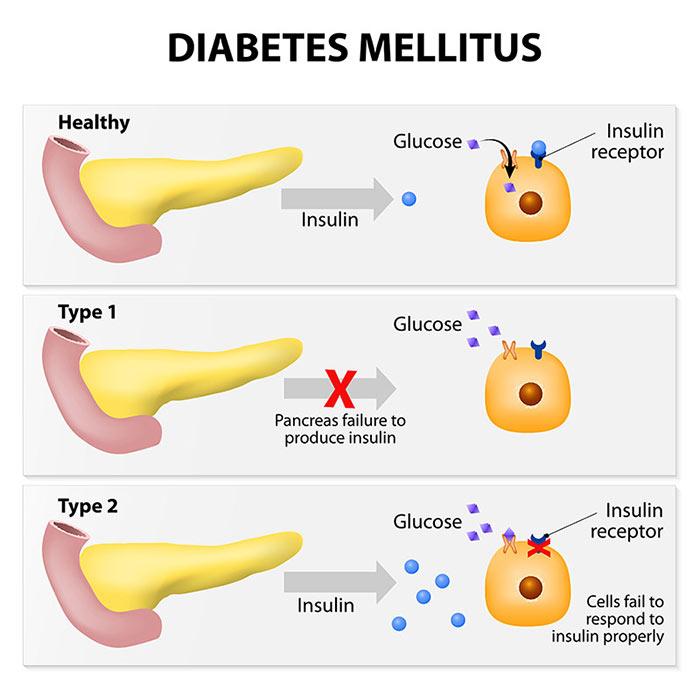Sarcoma in dogs
What are sarcomas?
Cancer affecting the bone or soft tissues of the body is known as sarcoma; the term is derived from a Greek word meaning “fleshy growth”. Sarcomas are fairly common in domestic dogs, accounting for roughly 15 percent of all canine cancers. They are most common in middle-aged and older dogs, especially in large and giant breeds.
Soft tissue sarcomas arise from connective tissues such as fat, muscle, cartilage, tendons, nerves and blood vessels. They typically develop either on the body surface or inside the organs (including the kidneys, liver, lungs, spleen and heart). They usually grow slowly in one location but can metastasize (spread) once they are established; the liver and lungs are the most common sites of metastasis.
External sarcomas usually present as a noticeable and progressively enlarging superficial mass. Sarcomas inside body organs are usually quite large before they are discovered. Some soft tissue sarcomas are well-defined and appear to be enveloped or encapsulated, while others are invasive and infiltrate surrounding tissues, having no distinct borders.
Sarcomas are divided into two main groups, bone sarcomas and soft tissue sarcomas. They are further sub-classified according to the type of cell of origin found in the tumour. These tumours tend to be grouped together because they all share certain biological characteristics and have similar outcomes. Some of the canine sarcomas are:
Osteosarcoma (bone cancer)
An aggressive cancer of the bones that can metastasise via the lymph system to other parts of the body, osteosarcoma is the most common primary bone tumour found in dogs, accounting for up to 85% of all malignancies originating in the skeleton. It can occur in any bone but the limbs account for the majority of all affected bones (‘appendicular osteosarcoma’). Osteosarcoma develops deep within the bone and can become excruciatingly painful as it grows outward and destroys the bone.
Osteosarcoma mostly occurs in middle aged to older dogs, with a median age of 7 years. Larger breeds such as Great Dane, Irish setter, Doberman Pinscher, Rottweiler, German Shepherd and Golden Retriever are at greater risk of contracting osteosarcoma because of their size and weight.
Hemangiosarcoma
This is a deadly cancer that originates in the endothelium (the walls of the blood vessels) and invades the blood cells. Hemangiosarcoma is more common in dogs than any other species and is most often seen in larger breeds like German Shepherds, Golden Retrievers and Labradors. It is mostly seen in middle-aged to older dogs and it appears that male dogs are slightly more predisposed than females. This type is often classified separately from the other categories of soft tissue sarcomas because of its more aggressive biological behaviour.
- Fibrosarcoma – arises from fibrous connective tissue
- Hemangiopericytoma – arises from cells surrounding small blood vessels
- Leiomyosarcoma – arises from smooth muscle tissue
- Liposarcoma – arises from connective tissue
- Lymphoma (Lymphosarcoma) – arises in lymph nodes and in organs with lymphoid tissue, including the bone marrow, liver and spleen
- Lymphangiosarcoma – arises from lymphatic tissue
- Neurofibrosarcoma – arises from nerve cells
- Rhabdomyosarcoma – arises from muscle cells
- Schwannoma – arises from nerve sheaths
- Synovial cell sarcoma
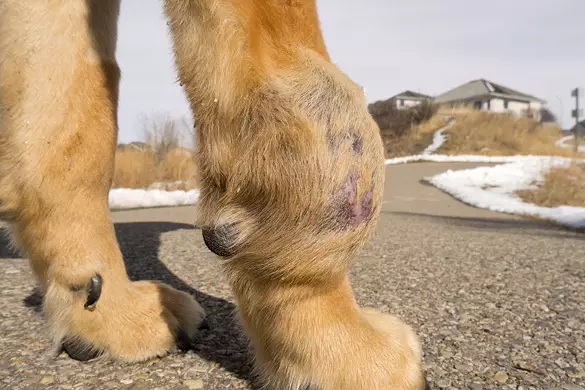
Symptoms of sarcoma in dogs
In most cases, sarcomas are discovered when a dog’s owner notices an external mass that appears to be progressively enlarging. The location of the sarcoma will influence its signs. For example, a sarcoma in the mouth may have signs of bad breath (halitosis), difficulty eating or swallowing and/or nose bleeds (epistaxis). A sarcoma in the gastrointestinal tract may present with vomiting and diarrhoea.
Symptoms to look out for include:
- Enlarged lymph nodes around the neck, the underarm and back legs
- Bloated Belly
- Pale gums
- Loss of energy
- Leg issues such as limping, change in gait, pain or swelling of the legs, especially if one leg is larger than the other
- Unusual growths or swelling
- Sudden changes in the dog’s health or behaviour
- Weight changes, especially sudden weight loss
- Increased thirst
Causes of sarcoma in dogs
Because we don’t understand what causes them, there is no real way to prevent soft tissue sarcomas in dogs. Early detection and treatment are the best ways to address these tumours. It is important to keep in mind that:
- Most sarcomas appear to arise spontaneously.
- Genetics and environmental conditions may play a role in the development of soft tissue sarcomas in dogs, but research in this area is still in its infancy.
- Some soft tissue sarcomas are believed to have been associated with metal implants, exposure to radiation, implanted microchips and certain parasitic infestations.
- Sarcomas at the site of injections (shots) are uncommon in dogs but do occur more commonly in cats.
How is sarcoma in dogs diagnosed?
Fine needle aspiration
A fine needle aspirate is an easy, non-invasive test that can often be used to confirm the presence of a sarcoma. Cell samples are removed from the site and evaluated to identify the type of soft tissue cells that are forming the mass.
Histopathology
Soft tissue sarcomas can only be definitively diagnosed by means of histopathology; the microscopic examination of tissue samples taken from the tumour. A biopsy may be necessary if fine needle aspirates are inconclusive. Biopsies can also be used to classify the specific type of soft tissue sarcoma.
Imaging
Radiographic imaging (X-rays) can be used to define the nature and extent of the tumour. Chest X-rays can also be helpful to identify any metastasis to the lungs.
More advanced diagnostic imaging, including ultrasound, computed tomography (CT scan) and magnetic resonance imaging (MRI), may be used to delineate the exact nature and extent of the tumour and assist the veterinarian in planning the best surgical approach for its removal.
Once a diagnosis of soft tissue sarcoma is made, the dog’s overall health will be evaluated and the disease will be staged to determine whether it has spread. Staging for sarcomas typically involves:
- Chest radiographs
- Abdominal ultrasound
- Evaluation of regional lymph nodes
- Blood work
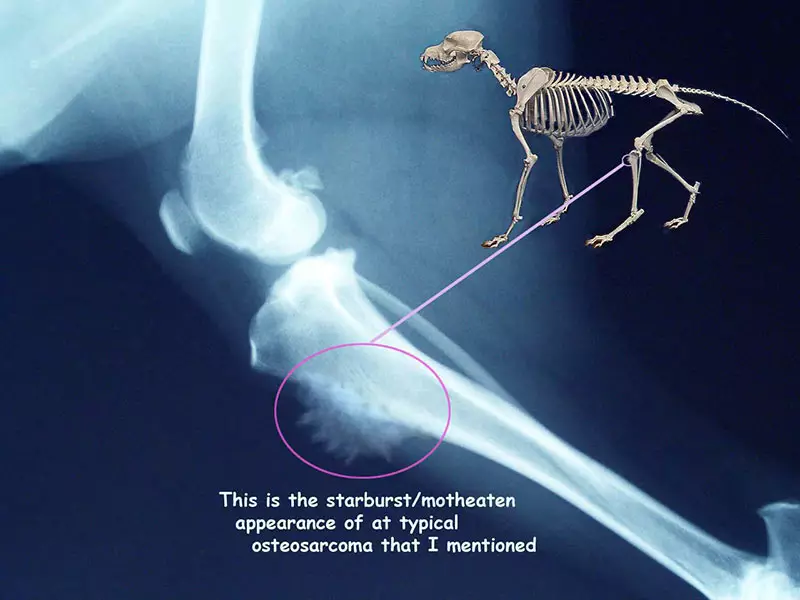
Prognosis
The outlook for dogs with soft tissue sarcomas is highly variable. Prognosis will need to take into account the type of sarcoma, its size, location, how early it is detected, the treatment administered and its stage and/or grade (how advanced it is and how likely it is to spread).
- Soft tissue sarcomas that are low to intermediate grade and can be removed completely with wide surgical margins, have an excellent long-term prognosis.
- Prognosis for low grade soft tissue sarcomas that are incompletely excised and followed by radiation therapy is very good; approximately 85% of these dogs are tumour free three years after treatment.
- Most dogs with incompletely excised soft tissue sarcomas that do not receive follow-up radiation will experience tumour regrowth within one year.
- For high-grade sarcomas, the long-term prognosis is guarded; chemotherapy may be performed to help delay the onset of metastasis, however, the median survival time for these dogs is approximately one year.
- Dogs with soft tissue sarcomas that have metastasised at the time of diagnosis usually have a poor prognosis.
Treatment for sarcoma in dogs
The goal of treating soft tissue sarcomas is to completely eradicate all cancerous tissue – in other words, to get rid of the tumour. If the tumour cannot be eliminated entirely, the goal becomes preventing or at least delaying the spread of cancerous cells to other tissues.
The primary treatment for sarcomas is surgery. If the tumour is graded as high grade or removal is incomplete, then adjunctive therapy such as radiation therapy and / or chemotherapy is recommended.
Surgery
- Aggressive surgical removal is considered to be the best way to treat this soft tissue sarcomas.
- Surgical excision aims to be wide and deep in order to remove all of the tumour tissue and to achieve clean surgical margins (the amount of normal tissue removed from around the tumour).
- When tumours are excised surgically with clean surgical margins no further treatment may be necessary.
- If the tumour is not removed with adequate margins, a second surgery may be recommended to ensure adequate removal of all tumour cells.
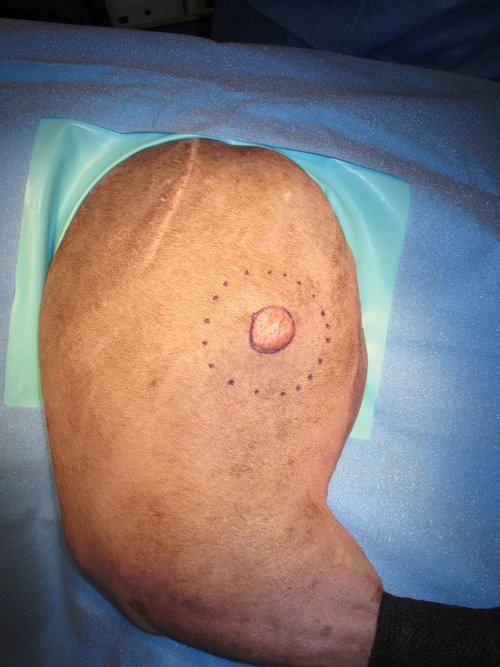
Radiation therapy
- Radiation therapy may be used to prevent or delay regrowth of the tumour.
- Side effects are temporary and limited to the site where radiation therapy is performed.
- In some cases, radiation may be recommended before surgery, especially if the tumour is located in an area that isn’t easily accessible for surgical removal.
- Radiation may also be used for large tumours that cannot be surgically removed.
- Palliative care may include radiation, as it may help alleviate the pain and discomfort caused by the sarcoma.
Chemotherapy
- Chemotherapy may be recommended for dogs with high grade sarcomas, dogs in whom the cancer has metastasised, or to prevent or delay the onset of metastasis.
- Chemotherapy may be administered by injectable or oral anti-cancer medications, as a single drug or as a combination of various chemotherapy drugs.
- Chemotherapy is generally well tolerated in dogs.
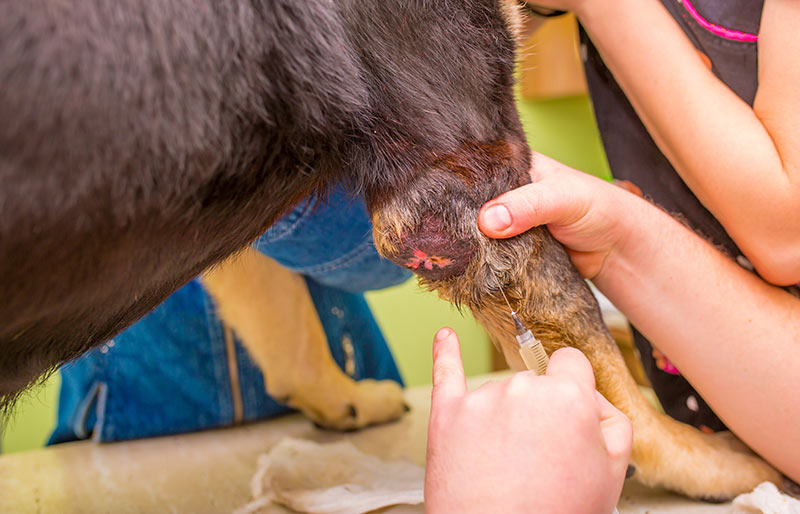
In summary
Sarcomas are malignant tumours that develop in the connective tissues of the body, including include, fat, blood vessels, nerves, bones, muscles, deep skin tissues and cartilage. They are classified together as because of their similar behaviour and outcome.
Sarcomas are a fairly common type of cancer in domestic dogs and are typically discovered when a dog’s owner notices a superficial growth that appears to be progressively enlarging.
The prognosis for canine sarcoma is highly variable and depends on many factors, including the type, size and location of the sarcoma. The recommended treatment for soft tissue sarcomas is surgical excision. Many dogs with soft tissue sarcomas can be successfully treated if the mass can be removed with wide surgical margins.
Bow Wow Meow Pet Insurance can help protect you and your dog should an unexpected trip to the vet occur.
-
Find out more about our dog insurance options
-
Get an online pet insurance quote


More information
- https://www.care.com/c/stories/6482/sarcoma-in-dogs-what-you-need-to-know/
- https://smallanimal.vethospital.ufl.edu/clinical-services/oncology/types-of-cancer-and-treatment/soft-tissue-sarcoma-in-dogs/
- https://www.petwave.com/Dogs/Health/Soft-Tissue-Sarcomas.aspx
- https://www.merckvetmanual.com/integumentary-system/tumors-of-the-skin-and-soft-tissues/connective-tissue-tumors#v3281240
- http://wearethecure.org/learn-more-about-canince-cancer/canine-cancer-library/
- https://sarcomaalliance.org/resources/what-is-sarcoma/
- http://wearethecure.org/learn-more-about-canince-cancer/canine-cancer-library/hemangiosarcoma/
- http://wearethecure.org/learn-more-about-canince-cancer/canine-cancer-library/osteosarcoma/
- http://www.animalcancersurgeon.com/principles-surgical-margins/
- http://www.animalcancersurgeon.com/skin-tumors-sts







